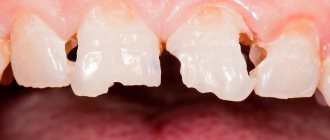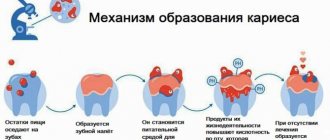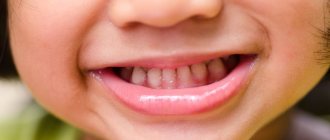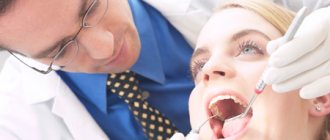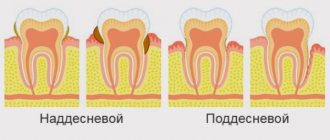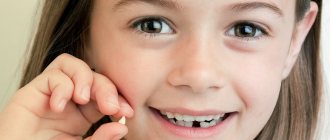Baby teeth are considered temporary, so parents often treat them without due attention. Care, treatment, and concern for the health of the oral cavity are usually postponed until later - when the baby’s temporary bite is replaced by a permanent one. And this is a big mistake, dentists warn. The attitude towards the primary dentition from the moment of its appearance should be as attentive as to the permanent one.
Why can't we trust prejudices? Do baby teeth need to be treated? Is it possible to pull them out at home? And when should you definitely see a dentist? FAN journalist asked these questions to the head of the dental department of the Medsi children's clinic on Pirogovskaya, pediatric dentist Natalya Terentyeva .
Content:
- Should baby teeth be treated?
- The most common dental diseases in childhood
- Treatment of baby teeth
- Anesthesia in pediatric dentistry
- What to do to avoid having to treat baby teeth
Parents often shake their heads negatively when asked whether baby teeth need to be filled. It seems to them that it is not at all necessary to do this, because very soon the temporary bite will be replaced by a permanent one. Dentists categorically disagree with this opinion. Doctors say that you need to take care of the health of your milk units just as thoroughly as your primary ones.
Should baby teeth be treated?
There are a number of reasons why it is imperative to take care of your child’s baby teeth. Among them:
- Negative changes in the bite in the case of premature destruction of individual teeth, violation of the location of permanent units. Because of this, in adolescence, a child has to wear braces, which cause him a lot of physical inconvenience and psychological complexes.
- The risk of infection transferring from a baby tooth to the permanent bud. These complications are possible with pulpitis, cysts, periodontitis. Bacteria can also penetrate bone tissue, and this is very dangerous for the health of a small patient.
- The development of diseases of the gastrointestinal tract as a result of premature destruction of dental crowns. Then the smile becomes partially toothless and it is difficult for the child to chew food. If large pieces of food enter the stomach, digestive processes worsen and slow down.
- Problems with diction and sound pronunciation. A “toothless” mouth contributes to the development of a lisp. Because of this, the child may be criticized by peers.
Also, when talking about whether it is necessary to treat baby teeth, doctors never tire of reminding them of the pain that a child faces if the dental disease that has arisen progresses. Is it worth exposing your baby to such torture? After all, they can be easily avoided by promptly treating temporary canines, incisors and molars.
How are the main diseases that cause pain treated?
Caries: in the initial stage, it can be cured without drilling with a bur. For the youngest, doctors use enamel silvering. For children from three years of age, fissure sealing techniques (on chewing units), fluoridation, and caries treatment using the Icon system are suitable. In the middle and deep stages of caries development, it is impossible to do without drilling out the affected tissues and installing a filling.
Pulpitis: the entire pulp is rarely removed in children; techniques are mainly used that help mummify the nerve. The doctor uses the vital amputation technique, when only the coronal part of the pulp is removed, while the root part is preserved. Less often, the pulp has to be completely removed using devital amputation - for this, an arsenic paste is first placed in the root canals, which kills the nerve. After treatment and disinfection of the canals, a filling is installed.
Periostitis: inflammation of the periosteum can only be cured through surgery. After opening and draining the abscess, the doctor prescribes medications, physiotherapy, and antiseptic rinses. It is not always possible to save a tooth in such a situation.
Abscess: the abscess is opened and drained, the root canals are disinfected. The doctor must prescribe antibiotics. If the abscess has affected not only the soft tissues of the oral cavity, but has also gone down, for example, to the neck, then the child will have to be hospitalized and treated in a hospital.
Fistula: if the size of the neoplasm is small, then it is opened and cleaned of pus, the root canals are processed and filled, but more often doctors remove the baby tooth, because With such a pathology, there is a high probability of damage to the rudiments of permanent units.
Gingivitis: here the therapy will be complex. The doctor will definitely prescribe professional oral hygiene, medication, vitamin therapy and physiotherapy, antiseptic rinses and compresses.
Only caries can be cured in one visit to the doctor, but all other diseases are not treated so quickly and easily. Therefore, it is in your best interests to show your child to a specialist as early as possible!
The most common dental diseases in childhood
Among the main problems that force children to undergo dental treatment:
- Caries. Children encounter it most often. The disease is found in more than 60% of children under six years of age. It especially often affects molars. This is due to their relief volumetric surface and the baby’s nutritional conditions. On the crown of molars, plaque is deposited more actively. Pathogenic microorganisms multiply in it. The result of their life activity is progressive caries. The difficulty is that in the first stages, parents are not always able to detect a carious cavity on their own. It looks like a light speck and practically merges with the healthy surrounding enamel. Not knowing about the presence of the disease, mothers and fathers postpone a visit to the pediatric dentist. When the child arrives for an appointment, the carious “hollow” already turns out to be very large.
- Periostitis (flux). A complication of advanced caries, caused by the spread of bacteria, damage to tooth roots and tissues adjacent to them. The cheek is swollen. A voluminous abscess forms on the surface of the gum. When palpated, acute pain occurs. Flux may worsen the baby's general condition.
- Periodontitis. Inflammatory periodontal disease. The latter is formed by: periodontal ligament, gums, root cement and alveolar bone. It hurts your baby to bite into hard food. His temperature rises and headaches appear.
All of these dental diseases are highly treatable. The most important thing is not to put off visiting a dental clinic until later.
What folk remedies can be used
For babies, you can only use rinsing with herbal decoctions - chamomile, sage, oak bark, St. John's wort, lemon balm.
You can try to reduce the intensity of pain using acupuncture massage techniques. Massage the upper part of the ear on the side where your baby feels pain in a circular motion for five minutes.
The use of compresses made from clove oil, propolis, Novocain, Aspirin, garlic and peppermint should be avoided, because these substances may not only not bring relief, but burn the mucous membrane, cause allergies, and bring even more problems.
Treatment of baby teeth
fluoridation
comes to the rescue . The enamel is treated with a fluorine-containing compound. Due to which it becomes stronger, the progression of the carious lesion is inhibited.
Advanced caries, like pulpitis and periodontitis, requires a filling procedure. It is carried out using local anesthetics, so neither the child nor his parents should be afraid of pain or severe discomfort.
When treating the roots of milk units, doctors use a special material, which in the future will be absorbed along with the roots. Thus, the treatment in no way changes the order of tooth replacement.
Anesthesia in pediatric dentistry
What type of anesthesia will be used during treatment depends on the degree of advanced disease. Most often, doctors use a spray that makes the gum tissue insensitive.
If the problem is serious, injectable painkillers are used. But so that the little patient does not feel pain during the injection, the doctor first lubricates the area where the needle is inserted with an anesthetic. This approach to pain relief makes even complex dental procedures not at all scary and as comfortable as possible for the little fidget.
General anesthesia in pediatric dentistry is used only for the most severe illnesses or if it is not possible to persuade the patient to open his mouth and sit quietly in a chair. Parents should not be alarmed if the doctor recommends general anesthesia. It involves the use of a modern, safe drug with a minimum number of side effects.
Treatment of caries in children
Children of different ages, at 2–3 years old, at 5–7 years old, and earlier and later, may experience problems with the health of their teeth and oral cavity. There are various reasons and grounds for this. But all these problems must be addressed without fail.
Do baby teeth hurt due to caries? It all depends on the stage and degree of development of the disease, but discomfort and pain always occur if there are problems.
Initial examination
The initial appointment is a very important moment, since the patient gets to know the doctor and the office. Our clinic has special children's rooms, where everything is arranged so that the little patient feels comfortable.
The doctor examines and assesses the general condition, and also recommends treatment, if necessary; If possible, treat immediately. If the doctor needs photographs of the jaw to clarify the diagnosis and obtain a more detailed clinical picture, then a diagnosis is prescribed.
Diagnosis of childhood caries
Our clinic uses modern equipment for diagnostics. Also, to obtain panoramic or lateral images of the jaw, a tomograph with a minimal radiation dose is used, which allows even children to be examined. In some cases, specialists from related fields are involved in diagnosis and treatment.
Further treatment
Further treatment involves analysis of the data obtained, on the basis of which the method is selected. For example, the treatment of caries on milk and especially permanent front teeth in small children or a school-age child has its own characteristics.
The treatment process itself is aimed at ensuring that the child is not afraid or in pain. If the area of damage is too large, treatment under general anesthesia is recommended.
Our modern dentistry clinic offers affordable prices for diagnosis, treatment and prevention of caries in children and convenient payment methods.
The treatment of caries of a temporary tooth includes anesthesia, cavity treatment, filling.
Delayed treatment of caries of a permanent tooth (stage 1) – anesthesia, cavity treatment, placement of a Vitremer filling. Subsequent treatment is according to the general therapy price list.
Prevention of caries in children
It is better to prevent any disease, especially children’s dental disease, than to treat it. And since small children need constant observation and control, especially when they need to do something not very pleasant or unloved. Therefore, primary prevention of caries in preschool children falls on the shoulders of parents.
What is included in this procedure?
- Teaching your child to regularly brush his teeth: brushing his teeth and removing food debris twice a day, morning and evening.
- Selection of hygiene products together with your doctor (toothpaste and brush).
- Healthy and balanced diet.
- The correct technique for brushing your teeth (the doctor will tell you and show you).
- You need to bring your child for medical examinations regularly.
- As a preventive measure, we can also recommend regularly (as prescribed by the doctor) fluoridation of your baby’s teeth.
How to determine that a child has caries
- White and brown spots are visible on the surface of the teeth;
- The child reports pain when eating cold or hot food and drinks;
- There was a smell from the mouth;
- The child refuses to eat because it hurts to chew and bite;
- The child chews only on one side.
Childhood caries tends to spread very quickly, so it is important to bring your child to the dentist as early as possible. At the Good Dentist Clinic, young patients are treated with the utmost care and understanding. Our doctors carry out any examination, treatment and prevention procedures in a friendly and playful manner, so that the child is not afraid of visits in the future and does not worry if he has to stay and have his teeth treated.
The main causes of early caries of primary teeth in children of primary and preschool age and the need for its treatment:
- Damage to the tooth buds during intrauterine development as a result of previous or chronic diseases in the mother, taking medications, etc.;
- Poor oral hygiene in a child from the moment the first teeth appear;
- Wrong eating habits;
- Long-term use of nipples (using bottles with nipples can lead to the development of bottle caries);
- Unbalanced diet;
- General health.
The causes of caries in a child are also the individual anatomical and physiological characteristics of the teeth: the thickness of the enamel and dentin layer, for example.
Treatment of caries of primary teeth
Treatment of young patients is not only a matter of competent and professional development of a process that includes relationships with the child. This is also communication and building relationships with his parents. Treatment of dental caries in children involves the use of anesthesia, sometimes even general anesthesia, if the child has a complex case of childhood caries. Therefore, parents always naturally have a question: isn’t this harmful for their baby?
Treatment of superficial caries is most often completed in one visit and includes cleaning, drying and filling the carious cavity. Treatment of deeper caries, especially if pulpitis is suspected, in baby or molar teeth may take longer. This is especially true for molars, which the specialist approaches with extreme caution and thoroughness, trying not to disrupt the process of root formation. If possible, they also try to preserve baby teeth, especially if there is more than a year left before they are replaced, since early removal of baby teeth often leads to improper growth of molars and their crowding.
About the safety of general anesthesia
Modern dentistry offers only safe anesthesia, which allows you not to be afraid of going to the dentist’s office and undergoing the treatment itself without pain. Today there are several methods of anesthesia: drug-induced sleep, sedation and anesthesia. Each method differs in the degree to which the patient is immersed in “artificial sleep.” You can ask the doctors at the Good Dentist Clinic about their features in detail.
When treating children, general anesthesia is used with success, but its choice is made depending on the individual characteristics of each case.
Main indications:
- fear of dentists;
- allergic reactions to local anesthesia;
- large volume of upcoming treatment (multiple caries in children);
- increased gag reflex;
- diseases of the central nervous system.
The use of general anesthesia in the treatment of children is an opportunity not to frighten the child, to avoid causing him psychological discomfort and painful sensations. While the little patient is “sleeping”, the doctor will do everything that is necessary. The use of general anesthesia is permitted only with the written consent of the parents.
Bottle caries in children
This is a disease that is diagnosed mainly in children aged 2–4 years. Caries occurs due to the child’s habit of drinking before bed or because of night bottle feedings: the child falls asleep, and food remains in the mouth, which provokes the appearance of bacteria and the development of caries.
The signs of bottle caries in children coincide with the characteristic manifestations of ordinary caries, that is, this is defeat and damage to dental tissue due to the presence of many bacteria in the oral cavity. Indirect reasons for the development of bottle tooth damage are considered to be weakened immunity, heredity and nutritional disorders (sweet cereals, juices, confectionery, etc.).
Most often, this type of caries affects the first four upper teeth, and the first stage is expressed by small light matte spots on their surface. A later stage is the complete destruction of enamel and dentin. In some cases, bottle caries does not develop, but this is rare. To avoid this, it is necessary to maintain oral hygiene after drinking a bottle of milk before bed.
Cervical caries on baby teeth
This type of caries is characterized by damage to the area between the base of the tooth and the gums, that is, in the cervical area. The first external signs are darkening of the enamel and white spots, which can only be noticeable when examined by a dentist. Subsequently, when the enamel is destroyed more and more, darkening at the base of the teeth becomes noticeable. The last stage is holes in the teeth that cannot be ignored, and the child’s complaints.
The reasons for the appearance of this type of caries are most often poor oral hygiene and the anatomical features of the child’s teeth. Cervical caries, like bottle caries, affects several teeth at once.
Treatment methods for caries of primary teeth in children
The “Good Dentist Clinic” uses an individual treatment method: these can be conservative methods or treatment with a drill.
The choice of method will depend on factors such as:
- biological age of the child (a child is a growing organism, so often his real age does not correspond to his biological age);
- anatomical and physiological features of the dental system and each tooth individually;
- anatomical and physiological features of the child’s development and general health;
- reasons for appeal.
Fissure sealing of primary teeth in children (prices, pros and cons, etc.)
The method allows you to stop or protect baby teeth from caries damage or its development in the early stages. There are small but quite deep grooves on the surface of the chewing teeth: these are places where food debris most often accumulates, and places where the enamel is very thin. Therefore, these places are affected by caries first.
Fissure sealing in children: what is it? This is more of a preventative than a curative measure to combat caries. The method involves filling, or “sealing,” the grooves with special means. Such “patches” allow you to close access to food debris and bacteria. And thanks to the presence of calcium and sodium in the medicinal materials, the process of remineralization occurs under the “patch”.
Fissure sealing in children has its pros and cons. How necessary a method is for a particular small patient depends on many factors, so you should follow the doctor’s recommendations.
Read more about fissure sealing
Treatment of caries in a child without a drill
There is no need to drill a small patient's teeth when caries appears in the form of white or pigmented spots.
Treatment of childhood caries without drilling may include:
- the use of manual means for gentle cleaning of the carious cavity;
- impregnation and sealing of the affected areas with special means to stop the spread of carious infection.
Methods that are more often used as preventive measures are also possible. For example, fluoridation and remineralizing therapy.
It should be remembered that you cannot do without a drill when there is serious damage to the teeth.
Stages of childhood caries (deciduous and permanent teeth)
There are several types and stages of development of childhood caries:
- Average caries . It is characterized by damage to the enamel and internal tissues of the tooth. One of the main signs of average caries is discomfort when eating cold or hot food, as well as sweet, salty or sour. Treatment of moderate caries in children is carried out using the filling method.
- Deep caries . This is a complex form in which the enamel and most of the internal tissues (dentine) are affected. This form cannot be left without treatment. Firstly, because such tooth lesions cause the child a lot of inconvenience and pain. Secondly, caries can affect an even larger area, in addition to the tooth pulp and root - also neighboring healthy teeth. Which, in turn, is fraught with the development of a milk tooth cyst. The complexity and duration of treatment depend on how much decay has damaged the tooth and how far it has spread.
- Acute caries in children . Occurs in children over 2 years of age. this form is characterized by mild symptoms (the child practically does not complain) and almost imperceptible external signs. As a rule, this form is associated with a deficiency of minerals in the body.
- Multiple caries in children . This form is expressed in the form of caries damage to a large number of teeth, sometimes all milk teeth are affected. Extensive treatment is required using several techniques and several visits to the dentist.
Of course, treatment of caries of primary teeth in children should begin without waiting for the deep and even middle stages. Otherwise, unpleasant, painful and even dangerous consequences for the child’s health are possible, such as pulpitis, which is expressed by acute pain at night, fever and subsequent swelling of the gums and cheeks and other symptoms. If the pathology is serious, periodontitis may develop, which most likely will lead to the removal of a baby tooth.
Is it necessary to treat caries on a child’s baby teeth, and what should be done?
Caries must be treated regardless of which teeth it appears on - children's milk teeth or adult permanent teeth. Caries is an infectious disease and, like any infection, spreads to healthy teeth and gums without treatment. This will entail additional or repeated treatment, which will be even more stressful for the child, not to mention pain while eating, sleeping or brushing teeth.
Is caries treated in baby teeth? Definitely yes. But the methods and intensity of treatment are selected by the doctor based on the age and individual characteristics of the teeth and the general health of the child.
Refusal or lack of treatment will lead to complications of dental diseases. Advanced caries reduces children's immunity, which leads to an increased risk of ENT and upper respiratory tract diseases.
Digestive disorders and gastrointestinal diseases are another consequence. A child with bad teeth cannot chew food normally, as a result of which it is poorly digested and absorbed by the body.
Baby teeth affected by caries without treatment can cause infection of the tissues near the molar buds, which leads to various anomalies in the development and growth of the main teeth.
The health of baby teeth largely determines the health of the primary teeth and the general health of the child as a whole.
What to do to avoid having to treat baby teeth
In order not to have to wonder whether it is necessary to treat baby teeth, it is necessary to pay maximum attention to preventive measures. These include:
- proper and regular brushing of teeth;
- visiting the dentist twice a year (or more often if the child is prone to dental diseases);
- using a high-quality toothbrush and toothpaste;
- balanced diet, avoiding eating a lot of sweets;
- rinse your mouth after every meal.
If you take care of your teeth, the risk of tooth damage will be much lower. This means that a visit to the dentist will mostly be associated with affordable and absolutely painless prevention.
List of things you should absolutely not do
- Do not heat the sore spot: heat will promote the spread of the inflammatory process. Heat is especially dangerous if there is purulent inflammation. Do not forget that vital organs and the brain are in close proximity to the oral cavity, and the spread of infection can result in sepsis or meningitis.
- You should not give your child “adult” drugs, tablets or strong painkillers. Children can only be given analgesics based on ibuprofen and paracetamol, and instructions and dosage must be strictly followed.
- You cannot try to cure a dental disease on your own, open a filling, or influence soft and hard tissues.
